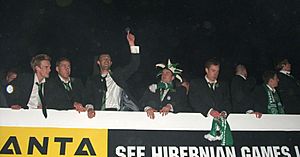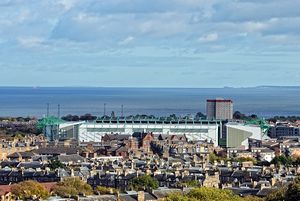Hibernian F.C. facts for kids
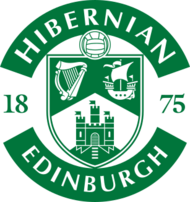 |
||
| Full name | Hibernian Football Club | |
|---|---|---|
| Nickname(s) | Hibs, The Hibees, The Cabbage | |
| Founded | 6 August 1875 | |
| Ground | Easter Road, Edinburgh | |
| Capacity | 20,421 | |
| Owner | Bydand Sports | |
| Chairman | Ian Gordon | |
| Head coach | David Gray | |
| League | Scottish Championship | |
| 2015–16 | Scottish Championship, 3rd | |
|
|
||
Hibernian Football Club, often called Hibs, is a professional football team from Edinburgh, Scotland. They play in the top league of Scottish football. The club started in 1875, created by people from Edinburgh's Irish community. Its name comes from "Hibernia," an old Latin word for Ireland.
The club's Irish roots are seen in its name, colors, and badge. Their main shirt color is green, usually with white sleeves and shorts. Hibs' biggest local rivals are Heart of Midlothian, and their matches are known as the Edinburgh derby.
Hibs play their home games at Easter Road, which they have used since 1893. Fans often call the team "The Hibees" or "The Cabbage."
Hibernian has won the Scottish league championship four times. Their most recent league win was in 1952. Three of these wins happened between 1948 and 1952, thanks to their famous group of attackers known as The Famous Five. The club has also won the Scottish Cup three times (1887, 1902, and 2016). The 2016 victory was very special as it ended a long wait for the cup. Hibs have also won the Scottish League Cup three times (1972, 1991, and 2007). In 1955–56, Hibernian became the first British team to play in a European competition, reaching the semi-finals of the first ever European Cup.
Contents
Club History
How Hibs Started (1875–1939)
The club was founded in 1875 by Irish people living in the Cowgate area of Edinburgh. They chose the name Hibernian (from Hibernia, an old name for Ireland), the color green, the Celtic harp, and the Irish phrase Erin go bragh (meaning Ireland Forever) as their early symbols.
Hibs quickly became a strong team in Scottish football during the 1880s. They were the first club from the east coast of Scotland to win a major trophy, the Scottish Cup in 1887. They even beat Preston North End, a top English team, in a friendly match called the Association Football Championship of the World Decider.
Due to problems, Hibs lost their home ground and stopped playing for a short time in 1891. But they found a new home at Easter Road in late 1892 and played their first game there in February 1893. The club still counts all its wins from 1875 onwards, including the 1887 Scottish Cup. Hibs joined the Scottish Football League in 1893.
Around this time, players no longer had to be part of the Catholic Young Men's Society. Today, Hibs is not seen as just an Irish or Catholic club. For example, the Irish harp was only put back on the club badge in 2000. The current badge shows three important parts of the club's identity: Ireland, Edinburgh (with the castle), and Leith (with a ship).
After restarting, Hibs had some success, winning the Scottish Cup in 1902 and their first league championship a year later. However, they then had a long period without winning many trophies. They were even relegated (moved down a league) for the first time in 1931, but they returned to the top division two years later.
The Famous Five Era (1939–1959)
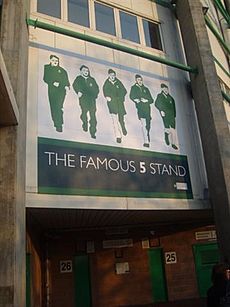
Hibs' most successful time was in the ten years after World War II. They were one of the best clubs in Britain. Their attacking players – Gordon Smith, Bobby Johnstone, Lawrie Reilly, Eddie Turnbull, and Willie Ormond – were known as the Famous Five. Many people thought they were the best attacking line-up ever in Scottish football. Each of them scored over 100 goals for Hibs. The north stand at Easter Road stadium is now named after them.
In the first season after the war, Hibs reached the 1947 Scottish Cup final but lost. With Lawrie Reilly joining the team, Hibs won the Scottish league championship in 1947–48, their first since 1903. They won the league again in 1950–51 and 1951–52. They almost won a third title in a row in 1952–53, but lost out on the last day. The Famous Five played together until March 1955, when Bobby Johnstone was sold.
Even though they finished fifth in the Scottish League in 1955, Hibs were invited to play in the first ever European Cup. This was because the competition wasn't just for league winners back then. Hibs became the first British club to play in Europe. They beat teams like Rot-Weiss Essen and Djurgårdens IF to reach the semi-finals. There, they lost to Stade de Reims, a strong French team.
Turnbull's Tornadoes (1960–1989)
Hibs often played in the Fairs Cup in the 1960s, winning against famous clubs like Barcelona. However, they didn't win much in Scotland until former player Eddie Turnbull became manager in 1971. His team, nicknamed Turnbull's Tornadoes, finished second in the league in 1974 and 1975. They won the League Cup in 1972. They also famously beat their rivals Hearts 7–0 at Tynecastle on New Year's Day 1973.
After the mid-1970s, Hibs' performance dropped. Turnbull left, and Hibs were relegated again in 1980. They quickly returned to the top league in 1981 but struggled through the 1980s.
1990s: Saving the Club
In 1990, Hibs faced serious money problems. Wallace Mercer, the chairman of Hearts, tried to merge the two clubs. However, Hibs fans saw this as a hostile takeover and started a group called Hands off Hibs to save their club. They succeeded when a local businessman, Sir Tom Farmer, bought a controlling share in Hibs. Farmer was convinced to help partly because a relative of his had also helped save Hibs from financial trouble in the 1890s.
After this, Hibs had some good years in the early 1990s, winning the 1991 Scottish League Cup final and finishing high in the league. In 1998, Alex McLeish became manager. Hibs were relegated again but immediately won promotion back to the top league in 1999.
2000s: A New Generation
Hibs had a good season in 2000–01, finishing third in the league and reaching the 2001 Scottish Cup final, which they lost to Celtic. Manager Alex McLeish left in December 2001. After a short, difficult period with a new manager, Bobby Williamson took over.
During this time, a "golden generation" of talented young players emerged, including Garry O'Connor, Derek Riordan, Kevin Thomson, and Scott Brown. These players helped Hibs reach the 2004 Scottish League Cup final, where they lost to Livingston. Williamson left, and Tony Mowbray became manager. Hibs finished third in his first season, and Mowbray won an award for best manager.
Mowbray left in October 2006, and former player John Collins took over. The team won the 2007 Scottish League Cup final under his leadership. However, the club sold key players like Kevin Thomson and Scott Brown for large amounts of money. Collins resigned later that year, unhappy about not having enough money to sign new players. Former Hibs player Mixu Paatelainen and then John Hughes managed the team in the late 2000s.
2010s: Scottish Cup Victory
Hibs finished fourth in 2010 and qualified for the Europa League. After a poor start to the 2010–11 season, John Hughes left. Several managers followed, including Colin Calderwood and Pat Fenlon. Under Fenlon, Hibs reached the 2012 Scottish Cup final but lost badly to Hearts. They reached the 2013 Scottish Cup final again, losing to Celtic.
In 2014, Hibs were relegated after losing a play-off. Alan Stubbs became manager in June 2014. He couldn't get the team promoted right away, but the 2015–16 season brought great cup success. They reached the League Cup final but lost. Then, they won the Scottish Cup for the first time since 1902, with a 3–2 win against Rangers in the final. This victory ended a very long wait and changed the club's reputation.
After the cup win, Stubbs left, and Neil Lennon became manager. He led the team to promotion by winning the 2016–17 Scottish Championship. In their first season back in the top league, Hibs finished fourth and qualified for the Europa League. Lennon left in January 2019, followed by Paul Heckingbottom. Jack Ross was appointed manager in November 2019.
2020s: Recent Years
Hibs finished seventh in the 2019–20 league season, which was cut short by the COVID-19 pandemic. The next season, they finished third and reached the 2021 Scottish Cup final, but lost to St Johnstone. Jack Ross also guided Hibs to the League Cup final later that year but was sacked before the final.
Shaun Maloney and Lee Johnson then managed the team. Johnson led Hibs to a fifth-place finish and European qualification. However, his time ended after a tough start to the 2023–24 season.
After serving as caretaker manager several times, David Gray was appointed permanently in June 2024. Despite a difficult start to the 2024–25 season, Hibs went on a 17-game unbeaten run. This helped them finish third in the Premiership and qualify for European competition.
Team Colors and Badge
The main club colors are green and white, used since the club started in 1875. The team's uniform usually has a green body, white sleeves, and a white collar. The shorts are normally white, and the socks are green. Hibs have also used yellow, purple, black, white, and dark green for their away kits. In 1977, Hibs was the first club in Scotland to have a sponsor's name on their shirts.
Hibs wore green and white striped shirts in the 1870s, which later inspired the design for Celtic. From 1879 to 1938, Hibs wore all-green shirts. White sleeves were added in 1938, similar to Arsenal. In 2004, the shorts were changed to green to match the shirts, celebrating the 40th anniversary of a friendly win against Real Madrid in 1964. Green shorts were used in that match to avoid a color clash with Real Madrid's all-white kit.
The club badge has changed many times over the years. This shows an ongoing discussion about the club's identity: whether to proudly show its Irish heritage or to avoid it. The Irish harp was removed in the 1950s but put back on the badge in 2000. The current badge includes the harp (for Ireland), a ship (for the port of Leith), and a castle (for Edinburgh Castle).
| Period | Kit manufacturer | Shirt sponsor (front) | Shirt sponsor (sleeve) |
|---|---|---|---|
| 1976–1977 | Bukta | No sponsor | No sponsor |
| 1977–1980 | Bukta | ||
| 1980–1981 | Umbro | No sponsor | |
| 1981–1984 | Fisher's Alfa Romeo | ||
| 1984–1985 | No sponsor | ||
| 1985–1986 | Insave | ||
| 1986–1987 | P&D Windows | ||
| 1987–1988 | Adidas | ||
| 1988–1991 | Frank Graham Group | ||
| 1991–1992 | No sponsor | ||
| 1992–1994 | Bukta | Macbean Protective Coating | |
| 1994–1996 | Mitre | Calor | |
| 1996–1998 | Carlsberg | ||
| 1998–2004 | Le Coq Sportif | ||
| 2004–2009 | Whyte & Mackay | ||
| 2009–2010 | McEwan Fraser | ||
| 2010–2011 | Puma | ||
| 2011–2013 | Crabbie's | ||
| 2013–2014 | Nike | ||
| 2014–2017 | Marathon Bet | ||
| 2017–2019 | Macron | ||
| 2019–2020 | Hibernian Community Foundation | ||
| 2020–2021 | Thank You NHS | ||
| 2021–2023 | Joma | Utilita | |
| 2023–2024 | Bevvy.com | ||
| 2024– | SBK |
Home Stadium: Easter Road
Hibs played at different grounds before moving to Easter Road in February 1893. This has been their home stadium ever since.
Before rules changed, Easter Road had large standing areas and could hold over 60,000 fans. The record attendance was 65,860 for an Edinburgh derby on January 2, 1950. This huge crowd was drawn by the success of the Famous Five.
The pitch used to have a noticeable slope, but this was removed in 2000. Today, the stadium has seats for everyone and can hold 20,421 people. Easter Road is a modern stadium, with all four of its stands built since 1995. The newest part, the East Stand, was built in 2010.
The Scottish national men's team has played seven home matches at Easter Road. The Scottish national women's team also played their first game there in August 2019. Easter Road has also hosted other international matches and cup semi-finals.
Rivalry with Hearts
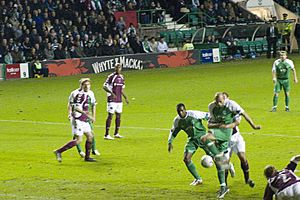
Hibs has a long-standing local rivalry with Hearts in Edinburgh. Their derby matches are some of the oldest in football history. The two clubs first played on Christmas Day 1875, with Hearts winning 1–0.
They have met in two Scottish Cup finals, in 1896 and 2012, both won by Hearts. The 1896 match was the only Scottish Cup Final ever played outside Glasgow.
Both clubs have won the Scottish championship four times. Hearts generally have a better record in derby matches. However, Hibs holds the record for the biggest derby win in a competitive game, beating Hearts 7–0 at Tynecastle on New Year's Day 1973. While some rivalries have religious or ethnic roots, this aspect is much less important in the Edinburgh derby compared to other rivalries in Scotland. The rivalry is mostly friendly and has even had good effects on the city's football.
Fans and Club Culture
Hibernian is one of only two full-time professional football clubs in Edinburgh, Scotland's capital city. In the 2022–23 season, Hibs had the fourth-highest average attendance in the Scottish leagues, with 17,469 fans per game. After World War II, Hibs often had over 20,000 fans at games, reaching a peak of 31,567 in the 1951–52 season. Since Easter Road became an all-seater stadium in the mid-1990s, attendance has varied. There has been a big increase in recent seasons, especially after their Scottish Cup win in 2016 and promotion in 2017.
Books and Stories
The books by author Irvine Welsh, especially Trainspotting, often mention Hibernian. The team is frequently talked about, and many of his characters support Hibs. In the movie Trainspotting, you can see references to Hibs, like a character wearing a Hibs shirt.
In one of Welsh's short stories, a boy from the "Hibs firm" (a group of fans) is struck by lightning and his soul moves into a baby's body. Hibs' appearances in the 2012 and 2016 Scottish Cup finals are also described in Welsh's later novels.
Hibernian is also often mentioned in the Inspector Rebus detective novels by Ian Rankin. While the main character, Rebus, supports another team in the books, he is a Hibs fan in the TV show. His colleague, Siobhan Clarke, is a loyal Hibs supporter.
Music and Songs
The Hibs song "Glory, Glory to the Hibees" was written by Scottish comedian Hector Nicol. Former Marillion singer Fish is a Hibs fan, and Easter Road is mentioned in his song "Lucky."
The Proclaimers are lifelong Hibs fans and helped save the club in 1990. Their song Sunshine on Leith has become a Hibs anthem. It is traditionally played after big wins at Easter Road and after cup finals. In their song "Cap in Hand," The Proclaimers mention a Hibs player:
I can understand why Stranraer lie so lowly
They could save a lot of points by signing Hibs' goalie
Another Proclaimers song, "Joyful Kilmarnock Blues," is about a Hibs away victory:
I'd never been to Ayrshire
I hitched down one Saturday
Sixty miles to Kilmarnock
Just to see Hibernian play
Television
Hibs is featured in the TV show Succession. In one episode, a character buys Hearts thinking it's his father's favorite team. But his father then reveals he is actually a Hibs supporter.
Club Ownership and Money
The football club started in 1875 but became a company in 1903. It was a private company until 1988 when its shares were sold on the London Stock Exchange. This made Hibs open to a takeover attempt in 1990 by Hearts chairman Wallace Mercer. This was stopped when Sir Tom Farmer bought control of the club for £3 million. Farmer helped fund stadium improvements and covered the club's financial losses.
In December 2014, the club announced plans to sell up to 51% of its ownership to its supporters. By November 2017, fans owned 34% of the club. In July 2019, Ronald Gordon, a businessman from Peru and the US, bought the majority ownership and became the chairman. Ronald Gordon sadly passed away in February 2023, and his family took over his shares.
In February 2024, a deal was approved with Black Knight, a major shareholder of the English club AFC Bournemouth. As a result, the Gordon family still owns most of the club (60%), and Black Knight bought 25% for a £6 million investment.
Players
First Team Squad
|
|
Players on Loan
|
Women's Team
The Hibernian women's team started in 1997. They became one of Scotland's top women's teams. Hibernian Women won the Scottish Women's Cup in 2010, and then won domestic cup doubles in 2016, 2017, and 2018.
Before the 2020 season, the club was renamed Hibernian Women, and players were offered their first part-time professional contracts. In July 2022, the women's first team became a full part of the men's club.
Club Officials
Coaching Staff
Source: Board of Directors
Source: |
Backroom Staff
Source: |
Famous Players
Lewis Stevenson holds the record for the most league appearances for Hibs, playing over 450 games by 2023. All of the Famous Five – Gordon Smith, Eddie Turnbull, Lawrie Reilly, Bobby Johnstone, and Willie Ormond – scored over 100 league goals for Hibs.
Hibernian players have played for 31 different national teams. 69 Hibs players have played for Scotland. Hibernian is the fifth-highest club in Scotland for providing players to the national team. Lawrie Reilly holds the record for the most international games played while a Hibs player, with 38 appearances for Scotland. In 1959, Hibs player Joe Baker became the first player not from an English club to play for England.
To celebrate the club's 135th birthday in 2010, Hibs created a Hall of Fame. The first group of famous players were added that year.
Famous Managers
From 1875 to 1903, Hibs was managed by a committee. However, Dan McMichael was the main manager when the club won the Scottish Cup in 1902 and the league championship in 1903. Willie McCartney was in charge for part of the league-winning 1947–48 season but sadly passed away. Hugh Shaw then took over and led the team to three league championships.
Alan Stubbs won the Scottish Cup in 2015–16, ending a 114-year wait for that trophy. Eddie Turnbull, Alex Miller, and John Collins each won one Scottish League Cup. Bobby Templeton, Bertie Auld, Alex McLeish, and Neil Lennon all won championships in the second tier of Scottish football.
Club Achievements
Major Trophies
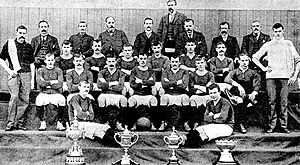
- Scottish League (Top Division)
- Winners (4): 1902–03, 1947–48, 1950–51, 1951–52
- Runners-up (6): 1896–97, 1946–47, 1949–50, 1952–53, 1973–74, 1974–75
- Scottish Cup
- Winners (3): 1886–87, 1901–02, 2015–16
- Runners-up (12): 1895–96, 1913–14, 1922–23, 1923–24, 1946–47, 1957–58, 1971–72, 1978–79, 2000–01, 2011–12, 2012–13, 2020–21
- Scottish League Cup
- Winners (3): 1972–73, 1991–92, 2006–07
- Runners-up (8): 1950–51, 1968–69, 1974–75, 1985–86, 1993–94, 2003–04, 2015–16, 2021–22
Other Trophies
- Scottish League (Second Division): 1893–94, 1894–95, 1932–33, 1980–81, 1998–99, 2016–17
- Drybrough Cup: 1972, 1973
- Summer Cup: 1941, 1964
- Southern League Cup: 1943–44
- East of Scotland Shield: 60 times
- Rosebery Charity Cup: 22 times
- Wilson Cup: 14 times
- Glasgow Merchants Charity Cup: 1902
- Edinburgh Football League: 1901–02
- North-Eastern Cup: 1910–11
- Dunedin Cup: 1921, 1929
Club Records
Attendance Records
- Highest single game attendance: 65,860 vs Hearts, January 2, 1950
- Highest average home attendance: 31,567 in the 1951–52 season
- Highest attendance for any match involving Hibs: 143,570 vs Rangers at Hampden Park, March 27, 1948
Game Records
- Biggest victory: 22–1 vs Black Watch Highlanders, September 3, 1881
- Biggest competitive victory: 15–1 vs Peebles Rovers, February 11, 1961
- Biggest league victory: 11–1 vs Airdrie, October 24, 1959 and vs Hamilton, November 6, 1965
- Biggest defeat: 0–10 vs Rangers, December 24, 1898
Player Records
- Most competitive appearances: Gordon Smith, 636 games
- Most league appearances: Lewis Stevenson, 477 games
- Most capped player (played for national team): Lawrie Reilly, 38 times for Scotland
Goal Records
- Most competitive goals: Gordon Smith, 303 goals
- Most league goals: Lawrie Reilly, 187 goals
- Most competitive goals in a season: Joe Baker, 46 goals in 1959–60
- Most league goals in a season: Joe Baker, 42 goals in 1959–60
Transfer Records
- Record fee paid for a player: Undisclosed (over £1,000,000) for Thibault Klidjé from Luzern in 2025
- Record fee received for a player: £4,400,000 for Scott Brown from Celtic in 2007
Images for kids
See also
 In Spanish: Hibernian Football Club para niños
In Spanish: Hibernian Football Club para niños



